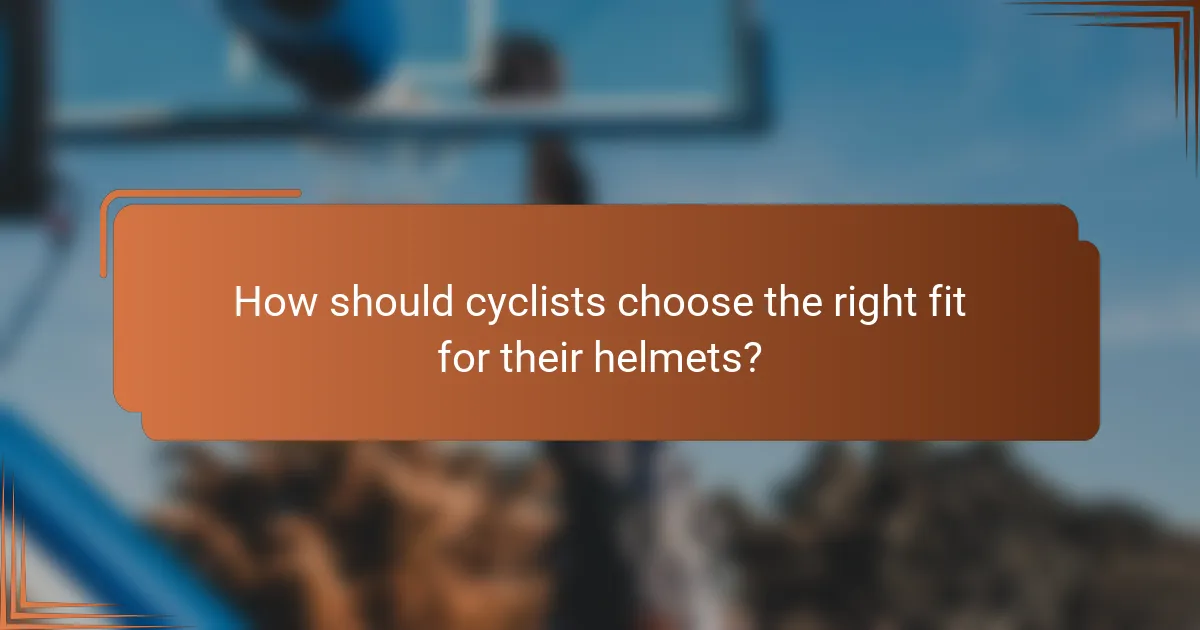Advanced aerodynamic helmets enhance cycling performance by reducing drag and improving comfort. Key features include streamlined designs, adjustable fit systems, and advanced ventilation. Proper fit ensures safety and optimal performance, while unique technologies like integrated visors add usability. Understanding these attributes can help cyclists make informed choices for better rides.

What are the key features of advanced aerodynamic helmets?
Advanced aerodynamic helmets feature streamlined designs, lightweight materials, and enhanced ventilation for improved performance. These helmets reduce drag, increase speed, and enhance comfort during rides. Key attributes include aerodynamic shape, adjustable fit systems, and moisture-wicking liners. Advanced models often incorporate unique technologies like integrated visors and sound systems, setting them apart from standard options.
How do materials impact helmet performance?
Materials significantly impact helmet performance by influencing weight, aerodynamics, and safety. Lightweight materials enhance comfort and reduce fatigue, while aerodynamic shapes minimize drag, improving speed. Advanced composites also provide superior impact resistance, crucial for cyclist safety. For instance, polycarbonate shells offer durability, while expanded polystyrene liners absorb shock effectively.
What are the design innovations in modern helmets?
Modern helmets feature advanced aerodynamic designs that enhance performance and safety for cyclists. Innovations include streamlined shapes that reduce drag, lightweight materials for comfort, and enhanced ventilation systems. These features improve speed and reduce fatigue during long rides. Additionally, customizable fit systems ensure optimal comfort and stability, catering to various head shapes.
Which aerodynamic technologies enhance speed?
Advanced aerodynamic helmets enhance speed through features like streamlined shapes, lightweight materials, and ventilation systems. These technologies reduce drag and improve airflow, allowing cyclists to maintain higher speeds with less effort. Helmets designed with wind tunnel testing often exhibit superior aerodynamic performance. Additionally, adjustable fit systems ensure optimal positioning, further enhancing speed and comfort during rides.

What benefits do advanced aerodynamic helmets provide for cyclists?
Advanced aerodynamic helmets enhance cycling performance by reducing drag, improving ventilation, and increasing comfort. These helmets typically feature streamlined designs, lightweight materials, and advanced ventilation systems. As a result, cyclists experience better speed and endurance during rides. Additionally, many models offer adjustable fit systems, ensuring optimal stability and safety.
How do these helmets improve comfort during rides?
Advanced aerodynamic helmets enhance comfort during rides through improved ventilation, lightweight materials, and customizable fit systems. These features reduce heat buildup, minimize fatigue, and ensure a snug yet comfortable fit, promoting longer and more enjoyable cycling sessions.
What role does ventilation play in performance?
Ventilation significantly enhances performance by regulating temperature and improving airflow. Proper ventilation in advanced aerodynamic helmets reduces heat buildup, allowing cyclists to maintain focus and stamina during rides. Effective airflow also minimizes sweat accumulation, contributing to comfort and visibility. Helmets designed with optimal ventilation can lead to improved endurance and overall cycling efficiency.
How do aerodynamic helmets affect cyclist safety?
Advanced aerodynamic helmets significantly enhance cyclist safety by improving head protection and reducing drag. These helmets feature streamlined designs that minimize wind resistance, allowing cyclists to maintain higher speeds with less effort. Additionally, many advanced models incorporate impact-absorbing materials that provide superior protection during crashes. A study indicated that properly fitted aerodynamic helmets can reduce the risk of head injuries by up to 30%. Furthermore, unique ventilation systems in these helmets ensure comfort during long rides, promoting safer cycling practices.

How should cyclists choose the right fit for their helmets?
Cyclists should prioritize fit, safety, and comfort when choosing advanced aerodynamic helmets. A proper fit ensures optimal performance and protection.
1. Measure head circumference accurately using a soft tape measure.
2. Try on multiple helmet sizes and styles to find the best fit.
3. Check for a snug fit without pressure points; the helmet should sit level on the head.
4. Ensure the retention system is adjustable and secure.
5. Test the helmet by shaking your head; it should remain stable.
6. Look for additional features like ventilation and weight that enhance comfort during rides.
What are the common sizing guidelines for helmets?
Common sizing guidelines for helmets include measuring the head circumference and referring to manufacturer size charts. Most helmets are available in small, medium, large, and extra-large sizes, accommodating head circumferences that typically range from 20 to 24 inches. A proper fit should allow for a snug feel without pressure points, and the helmet should sit level on the head, covering the forehead. Adjustments can be made using internal padding or adjustment systems to ensure comfort and safety while cycling.
How do different brands approach fit customization?
Different brands approach fit customization for advanced aerodynamic helmets by utilizing unique sizing systems, adjustable fitting mechanisms, and personalized padding options. Brands like Giro and Specialized offer advanced retention systems that allow for fine-tuning the helmet’s fit to enhance comfort and aerodynamics. Additionally, some brands incorporate 3D scanning technology to create custom molds based on individual head shapes, providing a unique fit experience. Overall, the focus is on improving both performance and comfort through tailored fitting solutions.
What adjustments can enhance helmet comfort?
Adjustments to enhance helmet comfort include proper fit, ventilation, padding selection, and strap adjustments. Ensuring the helmet fits snugly without pressure points is crucial. Adequate ventilation prevents overheating during rides. Choosing high-quality padding materials can improve comfort over long distances. Lastly, adjusting the straps correctly ensures stability and minimizes movement.

Why do some advanced aerodynamic helmets stand out from the rest?
Advanced aerodynamic helmets stand out due to their superior design, materials, and technology. These helmets reduce drag, enhance ventilation, and provide a better fit for cyclists. Features like integrated visors and adjustable straps improve usability. Advanced models often use lightweight carbon fiber, making them unique in performance and comfort.
What unique attributes do premium models offer?
Premium models of advanced aerodynamic helmets offer unique attributes such as enhanced ventilation systems, superior weight reduction, and advanced impact resistance. These features improve comfort, performance, and safety for cyclists. Additionally, some models incorporate customizable fit systems and integrated communication technology, setting them apart in the market.
How do brand reputations influence helmet selection?
Brand reputations significantly influence helmet selection by affecting consumer trust and perceived quality. Cyclists often prefer brands known for safety, innovation, and performance. A strong reputation can lead to increased sales and customer loyalty. For instance, brands with high safety ratings and positive reviews are more likely to be chosen, as cyclists seek reliable protection. This trust in established brands can overshadow lesser-known options, impacting market dynamics.
Which rare features can enhance performance in specific conditions?
Rare features that enhance performance in specific conditions include advanced ventilation systems, customizable fit options, and integrated communication systems. These attributes allow for improved airflow, personalized comfort, and seamless connectivity, which can significantly boost a cyclist’s efficiency and safety in varying environments. For instance, helmets with dynamic ventilation adjust to temperature changes, optimizing comfort during intense rides.

What are the common mistakes to avoid when selecting an aerodynamic helmet?
When selecting an aerodynamic helmet, avoid common mistakes that can compromise performance and safety. First, neglecting to prioritize fit can lead to discomfort and reduced aerodynamics. Second, overlooking ventilation can cause overheating during long rides. Third, ignoring weight can affect overall cycling efficiency. Fourth, failing to consider visibility features, like reflective elements, can reduce safety in low-light conditions. Lastly, not researching crash ratings may result in inadequate protection.
How can cyclists ensure they are choosing the best helmet for their needs?
To choose the best helmet, cyclists should prioritize fit, aerodynamic design, and safety certifications. A proper fit ensures comfort and stability, while advanced aerodynamic features enhance performance. Look for helmets with certifications like CPSC or EN1078 for safety assurance. Additionally, consider ventilation and weight to improve overall riding experience.
What are the best practices for maintaining helmet performance?
To maintain helmet performance, regularly inspect for damage, clean with mild soap, and store in a cool, dry place. Ensure proper fit by adjusting straps and pads, and replace helmets every three to five years for optimal safety. Check for ventilation and aerodynamic integrity to enhance cycling efficiency.